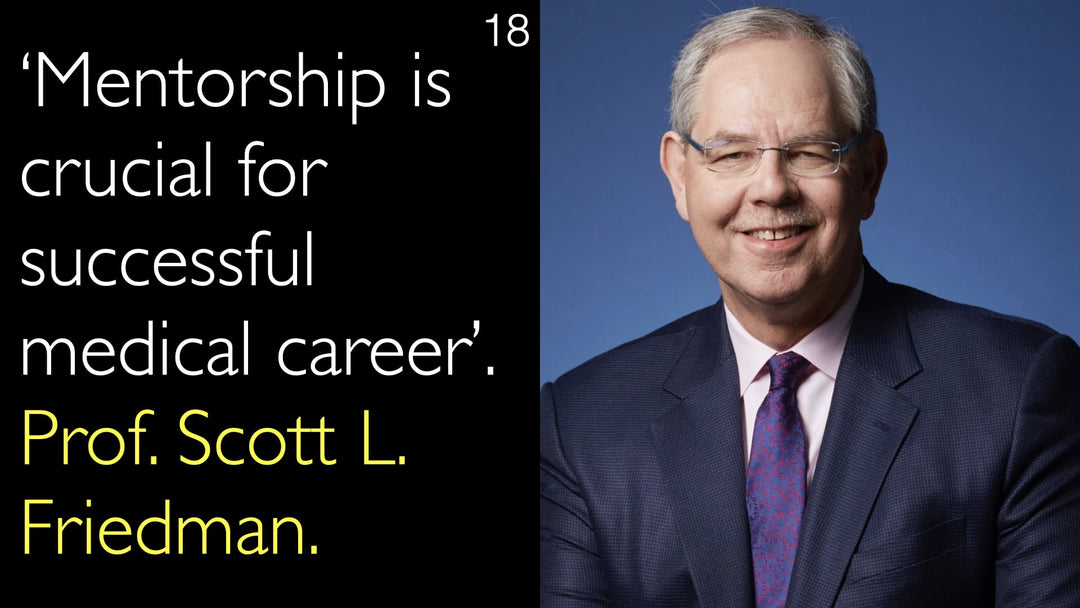Dr. Nelya Melnitchouk, en førende ekspert inden for kirurgisk uddannelse og work-life balance, belyser de særlige udfordringer, kvindelige kirurger står over for. Hendes forskning viser, at kvinder i procedureorienterede fag ofte har kortere barselsorlov og større økonomiske udfordringer. Dr. Melnitchouk diskuterer karrieretilfredshed og, hvordan den lange uddannelsestid påvirker familieplanlægning. Hun giver afgørende råd til unge kvindelige læger, der ønsker at kombinere en kirurgisk karriere med moderskab.
Udfordringer og løsninger for kvindelige kirurger: Barselsorlov og karrieretilfredshed
Spring til afsnit
- Forskningsresultater om kvindelige kirurger
- Påvirkning af den kirurgiske uddannelsestidslinje
- Karrieretilfredshed i procedureorienterede specialer
- Råd til unge kvindelige læger
- Barselsorlov i USA
- Systemiske pres og løsninger
- Fuld transskription
Forskningsresultater om kvindelige kirurger
Dr. Nelya Melnitchouk, kirurg og mor, gennemførte forskning inspireret af egne erfaringer. Hendes studier fokuserer på, hvordan medicinsk uddannelse påvirker livskvalitet og graviditetsforløb. Forskningen sammenlignede kvindelige læger i procedureorienterede og ikke-procedureorienterede specialer.
Resultaterne viser, at kvinder i kirurgi, obstetrik/gynekologi og gastroenterologi tager kortere barselsorlov. De står også over for større økonomiske forpligtelser over for deres klinik ved tilbagevenden. Dr. Melnitchouk påpeger, at disse kvinder rapporterer lavere karrieretilfredshed og et større ønske om at skifte speciale sammenlignet med kolleger i ikke-procedureorienterede fag.
Påvirkning af den kirurgiske uddannelsestidslinje
Den lange uddannelsesvej i kirurgi skaber betydeligt pres. Dr. Anton Titov og Dr. Melnitchouk diskuterer den typiske karrierevej: Efter medicinstudiet følger en fem til syv år lang residens, ofte efterfulgt af en fellowship for yderligere specialisering.
Denne udvidede uddannelse betyder, at læger typisk er færdiguddannede i midten af trediverne – en periode, hvor fertiliteten naturligt begynder at aftage. Dr. Melnitchouks forskning kunne ikke påvise øget brug af fertilitetsbehandling blandt kirurger, hvilket muligvis skyldes, at undersøgelsen inkluderede kvinder, der allerede havde fået børn.
Karrieretilfredshed i procedureorienterede specialer
Karrieremæssig utilfredshed er et væsentligt problem for kvindelige kirurger. Balancen mellem en krævende karriere og en ung familie er særligt udfordrende. Dr. Melnitchouks forskning inkluderede både residents og speciallæger.
Hun fandt, at udfordringerne var ens på tværs af grupperne. Presset fra at kombinere kliniske pligter og familieliv fører til udbrændthed, hvilket er en afgørende faktor for, at kvinder i procedureorienterede fag overvejer karriereskift.
Råd til unge kvindelige læger
Dr. Nelya Melnitchouk giver klare råd baseret på sine resultater: Vent ikke med at få børn, hvis det er et livsmål. Hun anerkender, at graviditet under residensen er udfordrende, men påpeger, at det også er svært som speciallæge.
Der findes ikke et perfekt tidspunkt. Hendes råd er at identificere personlige prioriteter og forfølge dem beslutsomt.
Barselsorlov i USA
Barselsorlovspolitikker i USA er uensartede og ofte utilstrækkelige. For læger under uddannelse er orlov typisk seks til otte uger, afhængigt af, om fødslen var kejsersnit.
Speciallæger kan være berettiget til op til 12 ugers orlov under Family and Medical Leave Act (FMLA). En væsentlig begrænsning er, at FMLA ikke kræver betalt orlov – det afhænger af den enkelte arbejdsgiver og klinik.
Systemiske pres og løsninger
Systemiske pres tvinger ofte kvindelige kirurger til at tage kortere barselsorlov. Dækning af en fraværende kirurgs patienter lægger en byrde på kolleger, hvilket skaber en følelse af professionelt ansvar for at vende tilbage hurtigt.
Der er også en betydelig finansiel byrde for sundhedssystemet. Dr. Melnitchouk konkluderer, at USA har brug for et bedre system med universel betalt barselsorlov for at støtte kirurgmødre og deres familier.
Fuld transskription
Dr. Anton Titov: Du studerer, hvordan medicinsk og kirurgisk uddannelse påvirker livskvalitet, graviditetsforløb og karrieretilfredshed hos kvindelige læger. Du har publiceret flere meget interessante forskningsartikler om dette emne. Hvad har du fundet frem til i din forskning om kvindelige læger?
Dr. Nelya Melnitchouk: Ja, dette projekt var af personlig interesse for mig, da jeg selv er kirurg og mor til to børn. Vi kom frem til flere interessante resultater.
Kvinder i procedureorienterede specialer tager kortere barselsorlov. De står over for større økonomiske forpligtelser over for deres klinik ved tilbagevenden. Procedureorienterede specialer omfatter kirurgi, obstetrik/gynekologi og gastroenterologi.
Kvinderne rapporterer lavere karrieretilfredshed og ønsker hyppigere at skifte speciale end kvinder i ikke-procedureorienterede fag. Dette kan også skyldes et udvalgsbias, da vi undersøgte kvinder i tidlige faser af deres forældreskab.
Alle deres børn er små, op til fem-seks år, og de står midt i deres kliniske karriere. De skal håndtere både professionelle forpligtelser og familie, hvilket er særligt udfordrende i en kirurgisk karriere.
Dr. Anton Titov: Lad os kort redegøre for den medicinske uddannelse i USA for internationale seere. Efter endt medicinstudium gennemgår unge læger typisk et femårigt residensprogram i procedureorienterede specialer. De arbejder som læger under stort pres. Derefter bliver de speciallæger, som du er nu.
Undersøgte du primært kvindelige læger under residensuddannelsen, fellowship eller allerede færdiguddannede speciallæger?
Dr. Nelya Melnitchouk: Vi undersøgte både residents og speciallæger – både dem under og efter endt uddannelse. Der var ikke stor forskel i barselsorlovens varighed eller de udfordringer, begge grupper står over for.
Det er korrekt, at den kirurgiske uddannelse i USA er meget lang. Efter medicinstudiet følger en residens på fem til syv år og ofte en fellowship. Når man er færdig, er man typisk i midten af trediverne – netop når fertiliteten begynder at aftage.
Vi undersøgte, om kvindelige læger brugte mere fertilitetsbehandling, eller om de havde problemer med at blive gravide. Vi kunne ikke bekræfte denne teori, men det kan skyldes, at vi kun inkluderede kvinder, der allerede havde fået børn.
Dr. Anton Titov: Du har udført og publiceret forskning om karrieretilfredshed og udfordringer for kvindelige kirurger. Hvilke råd vil du give til yngre kvindelige læger, der måske netop er færdige med studiet eller startet på deres residens?
Dr. Nelya Melnitchouk: Vent ikke med at få børn, hvis det er et af dine livsmål. Livet er uforudsigeligt, og man ved aldrig, hvad der kan ske. Graviditet under residensen er svært, men det er også udfordrende som speciallæge.
Find ud af, hvad der er vigtigt for dig, og gå efter det.
Dr. Anton Titov: Hvad er en typisk barselsorlovsperiode i USA, hvis man overhovedet kan tale om én?
Dr. Nelya Melnitchouk: Barselsorlov for læger varierer. For uddannelseskandidater er det typisk seks til otte uger, afhængigt af, om fødslen var kejsersnit. Som speciallæge kan man tage op til 12 uger, men noget er betalt, noget er ubetalt – det afhænger af den enkelte klinik.
I USA følger vi FMLA-reglen, som giver ret til 12 ugers orlov, men ikke kræver, at den er betalt. Realiteten er udfordrende.
Der er stort pres for at tage kortere orlov i højpresmiljøer. For det første skal en kollega dække dine patienter, hvilket lægger en byrde på partnerne, selvom man forsøger at kompensere efterfølgende.
Der er også en finansiel byrde for systemet. USA er nødt til at finde en bedre model for at give betalt barselsorlov til alle mødre.








